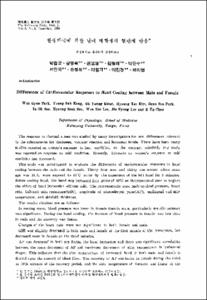한냉자극에 의한 남녀 대학생의 혈관계 반응
- Keimyung Author(s)
- Park, Won Kyun; Chae, E Up; Kim, Hyoung Tae; Park, Geun Soo
- Department
- Dept. of Medical Education (의학교육학)
Dept. of Physiology (생리학)
Dept. of Surgery (외과학)
Dept. of Pediatrics (소아청소년학)
- Journal Title
- Keimyung Medical Journal
- Issued Date
- 1984
- Volume
- 3
- Issue
- 2
- Abstract
- The response to thermal stress was studied by many investigators for sex differences relevant to the subcutaneous fat thickness, vascular reaction and hormonal levels. There have been many studies reported on women's response to heat condition, on the contrary relatively few study-was reported on response to cold condition. Recently, interests on women's response to cold condition has increased.
This study was investigated to evaluate the differences of cardiovascular responses to hand cooling between the male and the female. Thirty four men and thirty one women whose mean age was 21.6, were exposed to 10° C water by the immersion of the left hand for 5 minutes. Before cooling hand, the hand was immersed into water of 32° C as thermᄋneutral zone to neglect the effect of hand immersion without cold. The measurements were made to blood pressure, heart rate, Galvanic skin resistance(GSR), amplitude of photoelectric pulse(AP), sublingual and skin temperature, and skinfold thickness. The results obtained are as follows:
In resting state, blood pressure was lower in female than in male, particularly systolic pressure was significant. During the hand cooling, the increase of blood pressure in female was less than in male and the recovery was faster. Changes of the heart rate were not significant in both female and male. GSR was slightly decreased in both male and female at the first minute of the immersion, but decreased more in female at the third minutes.
AP was decreased in both sex during the hand immersion and there was significant correlation between the mean decrement of AP and maximum decrement of skin temperature in ipsilateral finger. This indicates that the skin temperature of immersed hand in both male and female is depend upon the amount of blood flow. The recovery of AP was faster in female during the third to fifth minutes of the recovery period, and the skin temperature of forearm and finger of the immersed side was rather higher in female than in male.
Mean skinfold thickness of female was significantly thicker than male, but in forearm the difference of skinfold thickness was little. Mean skinfold thickness and maximum decrement of skin temperature of the immersed hand were not related to each other during the immersion.
In summary, the difference of responses between male and female to hand cooling is seemed due to the difference of vascular reaction since the female has less peripheral vascular changes and a tendency of their faster recovery. The difference of the mean skinfold thickness between both sex did not influence on the response to the local hand cooling.
- Alternative Title
- Differences of Cardiovascular Responses to Hand Cooling between Male and Female
- Publisher
- Keimyung University School of Medicine
- Citation
- 박원균 et al. (1984). 한냉자극에 의한 남녀 대학생의 혈관계 반응. Keimyung Medical Journal, 3(2), 175–186.
- Type
- Article
- Appears in Collections:
- 2. Keimyung Medical Journal (계명의대 학술지) > 1984
1. School of Medicine (의과대학) > Dept. of Medical Education (의학교육학)
1. School of Medicine (의과대학) > Dept. of Pediatrics (소아청소년학)
1. School of Medicine (의과대학) > Dept. of Physiology (생리학)
1. School of Medicine (의과대학) > Dept. of Surgery (외과학)
Items in Repository are protected by copyright, with all rights reserved, unless otherwise indicated.
